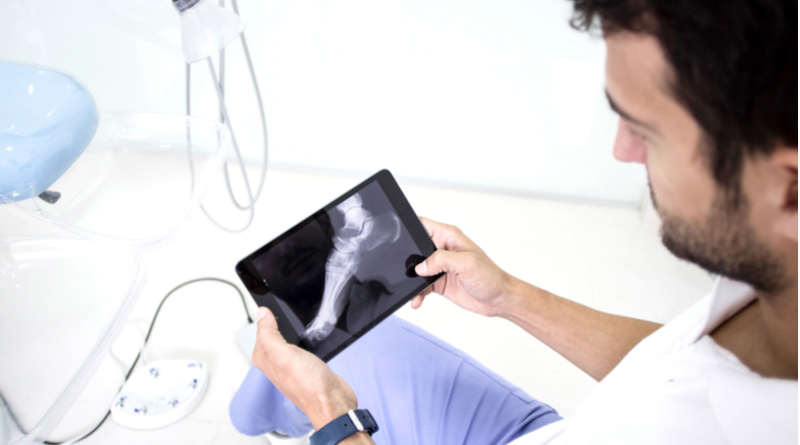What is Podiatric Medicine?
Podiatric Medicine is the branch of healthcare-associated with the foot, ankle, and connecting parts of the leg. A podiatrist is a foot doctor and will have DPM (Doctor of Podiatric Medicine) after their name, unlike Medical Doctors who have MD.
Both podiatrists and orthopaedists are qualified health specialists but the sphere of the treatment they provide is limited only to the ankle and foot areas. Podiatrists often treat ingrown toenails, calluses, fallen arches, heel spurs, and problems related to abuse or injury. They may employ surgical methods and may also treat such underlying health issues as diabetes, provided they are related to the foot or ankle problem.
What 3rd level courses are available?
Universities and colleges in Ireland are offering Podiatric Medicine courses in the following subject areas:
- Bachelor of Science (Podiatric Medicine) – The study of the management of disease and disorder of the lower limb and foot.
- Physiotherapy Studies – Gain an understanding of the principles and practices of rehabilitation and an insight into how to assess and treat clients whose movement is restricted.
- Occupational Therapy Studies – The study of rehabilitation and treatment of injured, ill or disabled patients through the therapeutic use of everyday activities.
- Certificate in Occupational Therapy Essentials – Learn how to work with both children and adults with limited physical and intellectual abilities.
Studying Podiatric Medicine in college
Like other types of physicians and surgeons, podiatrists complete four years of study and training in podiatric medical school. There are part-time courses and night courses available so you can be sure to fit in your studies no matter what your schedule is like.
You will study how bones, nerves, and muscles work together to help you move and you will also study the illnesses and injuries that can affect feet. That includes how to diagnose them and treat them and how to fix the feet with surgery if needed. Courses will cover all theory work through lectures, assignments, tutorials, and taught modules. Assessments will take place continuously with written examinations and practical assignments combined to achieve a qualification.
You will also be required to gain experience in residency training in hospitals and clinics. Work Experience will not only allow you to obtain a deeper knowledge and understanding of the industry, but it will also give you a chance to do some essential networking with other industry professionals and gain valuable contacts for the future. You may also work with doctors in other fields, including surgeons, anesthesiologists, pediatricians, and specialists in infectious diseases.
Career options
After completing a course in Podiatric Medicine you will be able to get started in a career that uses specific knowledge of clinical trials and research.
Working hours are typically 37.5 per week. If you’re based in private practice you may work more flexibly and might have to do some evenings and weekends for the convenience of patients. You can choose to combine freelance work with part-time work. This may include working for an existing private podiatry clinic, working in a GP surgery, making home visits, or doing locum work.
You could also work within High street podiatry services, complementary therapy clinics, sports clubs, private clinics, nursing homes, and occupational health centers. With experience, you may decide to set up your private practice. It is also possible to go into research or teaching where you could be employed by universities, hospitals, and clinics.
Work is on a one-to-one basis. Patients come from all age groups and backgrounds. They may often be children or the elderly. You may be part of a multidisciplinary team that can include GPs, nurses, dieticians, and physiotherapists in a range of settings such as hospitals, community clinics, and patients’ homes. You will need to feel comfortable working in what can sometimes be unpleasant working conditions, which include exposure to bodily fluids such as blood, pus, and urine.
You’ll need to travel locally to clinics, surgeries, and patients’ homes. The podiatrist qualification is widely recognized in Europe and beyond, giving you the chance to work overseas.
Related jobs include:
- Podiatrist
- Orthopaedist
- Physiotherapist
- Occupational Therapist
- Community clinician
- Medical sales representative
- Lecturer
- Researcher
- Self-employed locum working in private practices and private hospitals
Further study
After completing a course in Podiatric Medicine you may choose to pursue further study in a specialist field to increase your knowledge base and skillset.
Postgraduate study can also be used as a means to change career focus or to gain professional qualifications required to practice in certain career areas such as high-risk patient management working with patients who have an underlying illness or condition that puts their lower limbs at risk of infection or disability. This may include working in rheumatology, dermatology, or diabetes.
With experience and further training, you could also choose to specialize in areas such as biomechanics, forensic podiatry, nail surgery, orthotic manufacture, podiatric surgery, rehabilitation, and wound care.
FAQ
What are the responsibilities of a Podiatrist?
The role of a Podiatrist is to assess, diagnose, treat and evaluate abnormalities and diseases related to the foot and lower limb in people of all ages. They will provide treatment for high-risk patient groups such as the elderly and those with increased risk of amputation and give advice and make referrals to other healthcare and social services professionals as appropriate.
Podiatrists will use therapeutic and surgical techniques to treat foot and lower leg issues, prescribe and fit orthotics and other aids and appliances and deliver foot health education. They must understand the mechanics of the body to preserve, restore and develop movement.
Podiatrists work with people in sports to address sports-related injuries to legs and feet, use a range of equipment including surgical instruments, dressings, treatment tables, orthotic (inner sole) materials, lasers, grinders, shaping equipment, x-ray, and video gait-analysis equipment (which allows for analysis of patients’ walking or running problems) and will undertake a range of administrative tasks such as ensuring stock levels are maintained and securely stored, and that equipment is kept in good working order.
Where can I study Podiatric Medicine?
Explore your options here
Did You Know?
· Extra toes and fingers are technically known as polydactylism, and the condition is reported in about 1-2 of every 1,000 children.
· Compared with fingernails, toenails grow much more slowly — about 1 mm per month, whereas fingernails grow an average of 0.1 mm a day. It takes at least five to six months to grow an entirely new toenail.
· Each foot contains about 250,000 sweat glands. While the sweat itself doesn’t smell, socks and shoes can trap odor-causing bacteria, which thrive in dark, damp environments.
· Foot bones make up about a quarter of all the bones in our bodies.
· Humans have nearly 8000 nerves in our feet and a large number of nerve endings near the skin. Having ticklish feet can be a good sign: Reduced sensitivity can be an indicator of peripheral neuropathy (numbness in the feet caused by nerve damage)












Hello my name is Sabina, I’m Ukrainian podologist and would love so much to study podiatry or chiropody . I have en big experience in that but still it’s not enough, never enough. I ask you please help me to get started with that here in Ireland. Thank you so much
Please send me information about your evening classes in podiatry. Thank you